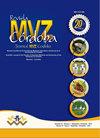在梅塔省各城市开展西尼罗河病毒流行病学监测
IF 0.3
4区 农林科学
Q4 AGRICULTURE, DAIRY & ANIMAL SCIENCE
引用次数: 0
摘要
目标。在梅塔省的8个城市确定马和蚊子中存在西尼罗河病毒。材料和方法。这项研究得到了洛斯亚诺斯大学生物伦理委员会的支持。613匹克里奥尔马和四分之一英里马的样本,用于体育和工作活动,年龄范围在2到15岁之间,使用血清学和分子测试分析了:比利亚维森西奥-雷斯特雷波-库马拉尔,圣马丁-新格拉纳达卡斯蒂亚和波多黎各洛佩兹-盖坦,分析了62个游泳池和213只蚊子。采用ELISA和PCR对马、蚊血清进行分析。结果。酶联免疫吸附试验未发现血清阳性动物,分子试验也均为阴性。结论。尽管在本研究中,Elisa技术未证实IgM抗体的存在,而且分子检测(RT-PCR)也未发现病毒循环,但在研究的城市中,重要的是要指出,在血清中进行分子检测,需要具有代表性的病毒血症水平,并且动物处于疾病的急性期。尽管马种群可能仍未接触到该病毒,但应继续开展流行病学监测,以防范这一对人类健康至关重要的病原体,特别是由于与此相邻的Meta省和Casanare省暴发了东部马脑炎和委内瑞拉马脑炎等其他人畜共患病毒。本文章由计算机程序翻译,如有差异,请以英文原文为准。
Vigilancia epidemiológica al virus del Oeste del Nilo en municipios del Departamento del Meta
Objective. Identify the presence of West Nile virus in horses and mosquitoes in eight municipalities of the department of Meta. Materials and methods. The research was supported by the Bioethics Committee of the University of Los Llanos. 613 samples of Creole and quarter-mile equine horses, intended for sports and work activities, with an age range of 2 to 15 years, were analyzed using serological and molecular tests in the transects: Villavicencio-Restrepo-Cumaral, San Martin- Castilla la Nueva-Granada and Puerto Lopez-Puerto Gaitan, analyzed in 62 pools and 213 mosquitoes. The pool of sera of horses and mosquitoes were analyzed by ELISA and PCR. Results. No seropositive animals were found by the ELISA test and molecular tests were also negative. Conclusions. Although in this study the presence of IgM antibodies was not evidenced by the Elisa technique, and molecular tests (RT-PCR) were also negative for viral circulation, in the municipalities under study, it is important to indicate that the molecular detection in sera, it requires representative levels of viremia and that the animal is in the acute phase of the disease. Although it is possible that the equine population remains free of contact with the virus, epidemiological surveillance should be maintained against this important pathogen for human health, especially due to the outbreak of other zoonotic viruses such as Eastern Equine Encephalitis and Encephalitis Venezuelan Equine in the departments of Meta and Casanare, adjacent to this.
求助全文
通过发布文献求助,成功后即可免费获取论文全文。
去求助
来源期刊

Revista Mvz Cordoba
农林科学-奶制品与动物科学
CiteScore
0.70
自引率
0.00%
发文量
41
审稿时长
6-12 weeks
期刊介绍:
The Journal MVZ Córdoba is an open access international scientific journal financed and edited by the University of Córdoba (Colombia). The journal publishes quarterly, continuously in PDF, XML, Epub, original articles, literature reviews, brief communications and clinical cases, peer-reviewed (double-blind) in Spanish and English, which are related to the agricultural and veterinary sciences. The journal is directed to natural and legal persons of veterinary medicine, animal husbandry, public health, epidemiology, aquaculture, biology, basic biomedical sciences and biotechnology and constitutes a space for academic and scientific discussion around the work of professionals in Veterinary Medicine and Zootechnics. Four-monthly publication.
"The Journal MVZ Córdoba supports the policies for registration of clinical trials of the World Health Organization (WHO) and the International Committee of Medical Journal Editors (ICMJE), since it recognizes the importance of these initiatives for international registration and dissemination. of information about clinical studies, in open access. As a result, since 2007, the journal MVZ Córdoba only publishes clinical research articles that have received an identification number in one of the Clinical Trial Registries validated by the criteria established by WHO and ICMJE, whose addresses are available in the ICMJE website. The identification number is recorded at the end of the summary. "
 求助内容:
求助内容: 应助结果提醒方式:
应助结果提醒方式:


